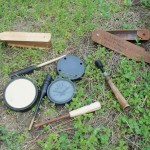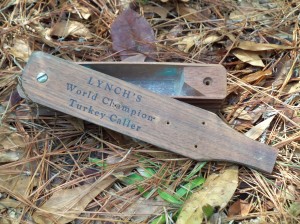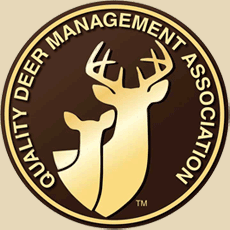When it comes to hunting turkeys, especially the eastern wild turkey in South Carolina, North Carolina and Georgia, hunters need to be aware that these are heavily pressured birds. Calling them into range can at times be difficult and challenging. However, for the prepared hunter, having the right call isn’t an option.
I have personally known a few hunters who rely solely on one call, be it a diaphragm, or a slate – and they seem to kill a few birds annually. However, if you have the opportunity to hunt with a truly skilled hunter one thing you notice right off the bat is that they are masters of all types of calls. From diaphragms, slate, box, trumpet calls, and tube calls, wingbone, and scratch box, they can use them all and use them all expertly. Mastering a specific call takes years of practice coupled with a lot of failures. However, those that do use them all, will consistently kill that “call shy” bird. Or get the 4 year old gobbler no one else can get to respond. Charles Hudson of Travelers Rest is one such master of them all.
Hudson, will readily say he prefers the slate and trumpet calls, because he makes his own. But when it comes to killing turkeys, Hudson is on a completely different level than even the most accomplished. His mastery of the scratch box is so precise, turkeys seem to willingly commit suicide just to get another listen to its tantalizing serenade. Hudson says, “turkey calls are musical instruments, just like you can’t master the violin with a few weeks of practice a year, you cannot master turkey calling with haphazard practice right before season opens.” Nothing is more truth than this, I dare say that most hunters, (me included) have been guilty of pulling out the ole diaphragm in early March to get ready for season, and we find that it is almost the end of the season before we have confidence in our calling abilities. The same is said of the slate, (be it made of slate, glass, ceramic or aluminum) it’s impossible to truly master these with only a few weeks of practice before entering the woods for a wise ole gobbler.
Like many turkey hunters, my turkey vest weighs almost 20 pounds because of all of the calls I carry into the woods. A typical arsenal will include; three box calls, three different slate type, (slate, ceramic, and glass) with seven different strikers. There is a tube call, a trumpet and wingbone, and an assortment of diaphragm calls that range the spectrum of cuts, and shapes. This adds up to almost fifteen different calls I have with me at all times. Some may say that is too much, but experience teaches me that on some days, the birds prefer a specific sound over another sound. When that happens I am ready.
Chad Simpson of Hendersonville, NC puts it like this; “Say you are at a party with a room full of fifty people all talking at the same time, then your wife calls your name, you immediately hear it over everything else. The same is true for turkeys, the difference is we don’t know what that voice is, so we have to be prepared.” If yelps from a slate with a hardwood striker gets no response, change strikers or slate material to change the pitch and see if that is the voice he likes. If not, then hit the trumpet call. One thing is for sure, especially on public ground, mature toms have heard it all. By having a different sound, from a different call, you are more apt to generate some interest.
Turkey hunters tend to be very superstitious, preferring a specific call over all the others. It might be because they killed their biggest bird using that call, or more using another regardless of the reason, we all have our ‘go to’ call. For me, it’s the M.L. lynch World Champion double sided box call. Arguable more turkeys have been lured to their demise using a box call than all others, and today, finding one that sounds like Mr. Lynch is rare. Certainly the modern mass produced calls do not have the tone of a genuine M.L. Lynch. Mine was purchased in 1979 at the Ace Hardware in Saluda, SC for $14.95. For a high school boy milking cows for spending money that was more than a full day’s wages. I still have the box with the price tag on it. My first turkey and many, many more have been seduced by Mr. Lynch. Sure it’s my ‘go to’ call. But some turkeys don’t prefer its sound, that’s why I have others ready to get their attention.
Another quality of different calls, is many are better at certain things. For example, my tube call, is my ‘reach out and touch them call’ Its loud, very loud, and has been known to generate a gobble at a quarter mile. While my ceramic with a carbon striker is my purr call, and my cutt call is the slate with hardwood striker. And the list goes on and on.
Regardless, to put more tags on more turkeys, learning how to use them all proficiently will help your confidence, and help your hunting more than relying on only one for all occasions.






